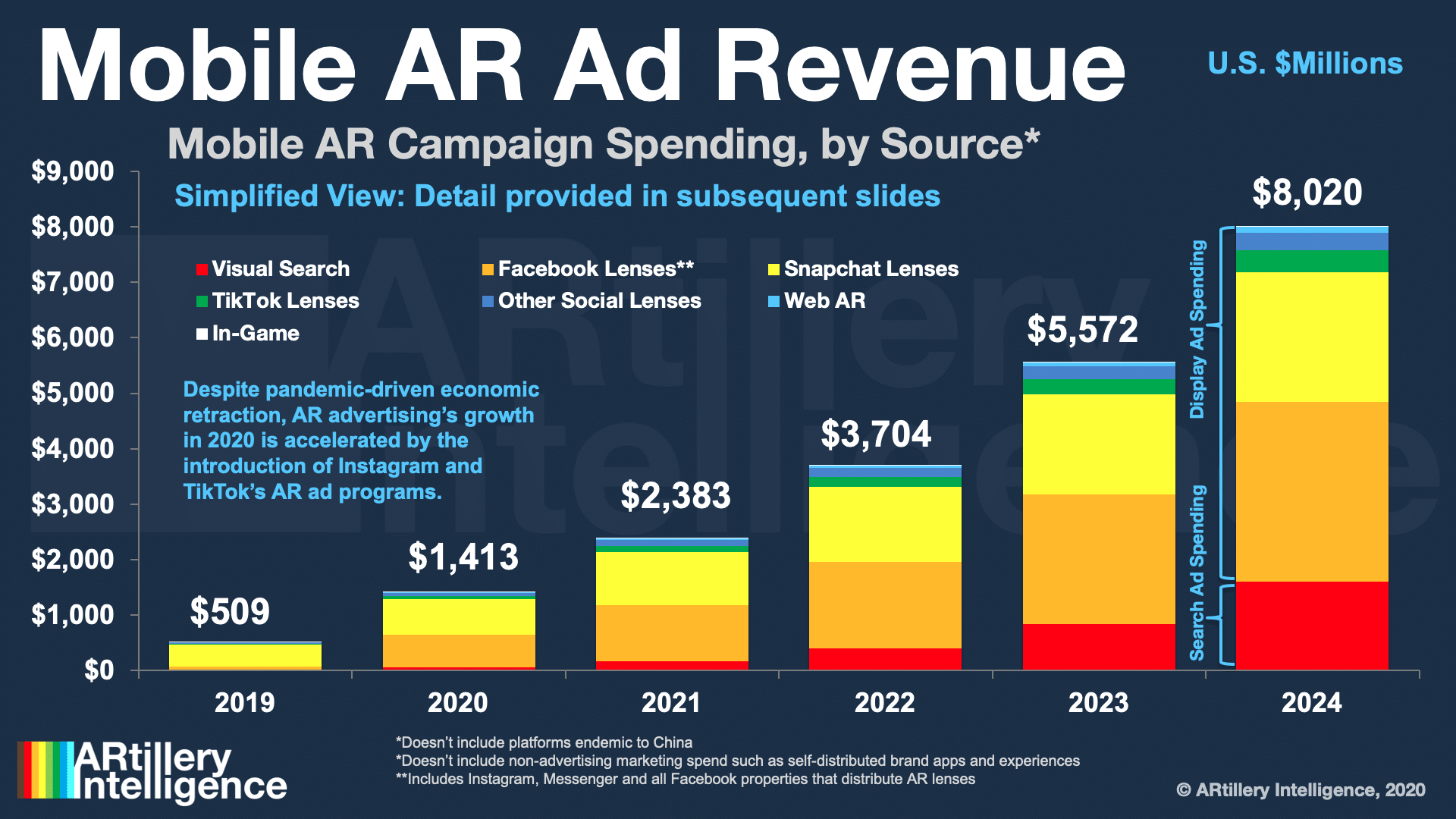
![]() ARtillery Briefs is a video series that offers insights in under 5 minutes. Each episode summarizes strategic takeaways from ARtillery’s original reports and market forecasts. See below narrative takeaways and embedded video. For the full library, subscribe to ARtillery PRO.
ARtillery Briefs is a video series that offers insights in under 5 minutes. Each episode summarizes strategic takeaways from ARtillery’s original reports and market forecasts. See below narrative takeaways and embedded video. For the full library, subscribe to ARtillery PRO.
Among AR sub-sectors that we examine, one of the most popular and revenue-producing is AR advertising. We’re talking branded AR lenses in channels like Facebook and Snapchat that let consumers visualize products on “spaces & faces” through the smartphone camera.
Revenue from these paid campaigns is expected to reach $1.4 billion this year according to the estimates of our research arm ARtillery Intelligence, growing to just over $8 billion by 2024. But key questions include how that’s all coming together? What’s driving it? And who’s doing what?
This is the topic of the latest report from ARtillery Intelligence, starting in part I of the series with a breakdown of the AR advertising competitive landscape. It’s also the topic of the latest ARtillery Briefs episode, which you can see below along with narrative takeaways.
Creative Muscles
First, to define what we’re talking about, AR advertising involves paid media placements that allow consumers to activate their smartphone camera and overlay branded animations. This involves paid distribution, as opposed to a brands’ self-distributed AR efforts like their own app.
This AR subsector is primarily driven by two factors. First, users are demonstrating high engagement with AR lenses as a way to enhance already-popular activities including media sharing and selfies. Second, advertisers are attracted to those eyeballs… as it often goes.
More specific to AR’s advantages, advertisers are drawn to its ability to let them flex creative muscles and transcend 2D media where they’ve been confined for years. There’s also a strong business case shown in campaign performance metrics that continue to validate AR’s ROI.
Lastly, AR offers versatility. It can achieve upper-funnel engagement to reach Superbowl-sized audiences in places like Facebook’s News Feed. And it can drive lower-funnel conversions through immersive product try-ons. Few ad media can claim this full-funnel capability.

Naming Names
So who’s doing what to tap into that advertiser demand? Snapchat is in the lead, due mostly to its dedicated focus on AR, and the medium’s alignment with its camera company mission. Facebook looms large with greater global scale in its Flagship app and News Feed distribution.
Facebook has also begun to distribute AR through other properties like Messenger and Portal. But the real opportunity could be Instagram, where AR aligns with its camera-forward audience and business model. Instagram has already cultivated a product-discovery use case.
Instagram has also made several moves over the past few years to be more transactional. That’s on a crash course with AR: Discovering products in the feed, then visualizing them in AR, then having a big shiny buy button to transact on the spot, is altogether a natural flow.
Meanwhile, wild cards include TikTok which has ample — though uncertain — AR potential. There’s also visual search, which carries the same high user intent that made web search such a strong business. Other developing channels including web AR, messaging and in-game AR.

Uncertain Future
We’re so early in AR’s lifecycle that these are all candidates for AR ad channels. Meanwhile, questions loom, such as scalable 3D asset creation. There’s also the question of analytics: Standard metrics like click-through rates, won’t really capture AR ads’ true engagement.
The broader state of consumer shopping and commerce is also a question mark. Covid-era retail lockdowns could end up accelerating AR’s role as a shopping utility. In other words, visualizing products in 3D gains value when we’ve lost the ability to try them on in physical stores.
But all this just scratches the surface. You can see more in the full report and video below. Also stay tuned for part II of this report series that’s built around case studies. Just like the early days of smartphone advertising, this will be a moving target with lots of growth and lots to learn.
